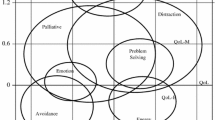Abstract
The utilisation of complementary and alternative medicine (CAM) is widespread in neuroimmunological diseases like multiple sclerosis (MS) but has been disregarded in research until lately. After describing the problems of definition in CAM, different categories will be described.
Various confounding factors on CAM utilisation exist, though hardly investigated. Besides sociodemographic variables like education, income, gender and age, illness-related factors like severity of disease are discussed. Furthermore, the important role of coping and CAM utilisation has not been investigated in neuroimmunological diseases, yet. Results derived from our investigations on CAM utilisation in MS indicate that users of CAM apply coping strategies, such as “rumination”, “search for information” and “search for meaning in religion”, more frequently than non-users and that current CAM utilisation is related to depression. Further research is needed in this field, as well as in other neuroimmunological diseases.
Similar content being viewed by others
References
Apel A, Greim B, König N, Zettl UK (2004) The role of coping and depression in utilisation of complementary and alternative medicine by multiple sclerosis patients. Mult Scler 10:138–139
Apel A, Greim B, König N, Zettl UK (2006) Frequency of current utilisation of complementary and alternative medicine by patients with multiple sclerosis. J Neurol 253:1331–1336
Apel A, Greim B, Zettl UK (2004) Utilisation of complementary and alternative medicine by multiple sclerosis patients. Mult Scler 10:114–115
Astin JA (1998) Why patients use alternative medicine. JAMA 279:1548–1553
Beekman R, Oosterhuis HJ (1994) Use of alternative treatments by patients with myasthenia gravis. Ned Tijdschr Geneeskd 138:294–296
Berkman CS, Pignotti MG, Cavallo PF, Holland NJ (1999) Use of alternative treatments by people with multiple sclerosis. Neurorehabil Neural Repair 13:243–254
Caspi O, Sechrest L, Pitluk HC, Marshall CL, Bell IR, Nichter M (2003) On the definition of complementary, alternative, and integrative medicine: societal mega-stereotypes vs. the patients' perspectives. Altern Ther Health Med 9:58–62
Edelson G, Levy Y, Shoenfeld Y (1999) Relapse of sarcoidosis after alternative medical treatment. Harefuah 136:849–850
Eisenberg DM, Davis RB, Ettner SL, Appel S, Wilkey S, Van Rompay M et al. (1998) Trends in alternative medicine use in the United States, 1990–1997: results of a follow-up national survey. JAMA 280:1569–1575
Ernst E, Casseleth BR (1998) The prevalence of complementary/alternative medicine in cancer: a systematic review. Cancer 83:777–782
Feinstein A (1997) Multiple sclerosis, depression and suicide. BMJ 315:691–692
Kranz R, Rosenmund A (1998) The motivation to use complementary medicine healing methods. Study of a general internal medicine and orthopedic patient sample. Schweiz Med Wochenschr 128:616–622
Launso L (2000) Use of alternative treatments in Denmark: patterns of use and patients' experience with treatment effects. Altern Ther Health Med 6:102–107
MacLennan AH, Wilson DH, Taylor AW (1996) Prevalence and cost of alternative medicine in Australia. Lancet 347:569–573
Moschen R, Kemmler G, Schweigkofler H et al. (2001) Use of alternative/complementary therapy in breast cancer patients – a psychological perspective. Support Care Cancer 9:267–274
National Center of Complementary and Alternative Medicine (NCCAM) (2006) What is complementary and alternative medicine (CAM)? http://nccam.nih.gov/health/whatiscam. Accessed: October 25th 2006
Nayak S, Matheis RJ, Schoenberger NE, Shiflett SC (2003) Use of unconventional therapies by individuals with multiple sclerosis. Clin Rehabil 17:181–191
O'Connor BB, Calabrese C, Cardena C et al. (1997) Defining and describing complementary and alternative medicine. Panel on Definition and Description, CAM Research Methodology Conference, April 1995. Altern Ther Health Med 3:49–57
Plunkett MV, Klein EW, Alldredge BK (2004) Use of complementary and alternative medicine products by persons with epilepsy. Epilepsia 45:148–149
Rajendran PR, Thompson RE, Reich SG (2001) The use of alternative therapies by patients with Parkinson's disease. Neurology 57:790–794
Sadovnik AD, Remick RA, Allen J, Swartz E, Yee IML, Eisen K (1996) Depression and multiple sclerosis. Neurology 46:628–632
Schubert DS, Foliart RH (1993) Increased depression in multiple sclerosis patients. A meta-analysis. Psychosomatics 34:124–130
Schwartz CE, Laitin E, Brotman S, LaRocca N (1999) Utilization of unconventional treatments by persons with MS: is it alternative or complementary? Neurology 52:626–629
Shirreffs CM (2001) Aromatherapy massage for joint pain and constipation in a patient with Guillian Barré. Complement Ther Nurs Midwifery 7:78–83
Sirois FM, Gick ML (2002) An investigation of health beliefs and motivations of complementary medicine clients. Soc Sci Med 55:1025–1037
Sirven JI, Drazkowski JF, Zimmerman RS, Bortz JJ, Shulman DL, Macleish M (2003) Complementary/alternative medicine for epilepsy in Arizona. Neurology 61:576–577
Stenager E, Stenager EN, Knudsen L, Jensen K (1995) The use of non-medical/alternative treatment in multiple sclerosis. A 5 year follow-up study. Acta Neurol Belg 95:18–22
Stenager EN, Stenager E, Koch-Henriksen N et al. (1992) Suicide and multiple sclerosis: an epidemiological investigation. J Neurol Neurosurg Psychiatry 55:542–545
Vincent C, Furnham A (1997) Complementary medicine: a research perspective. Wiley, Chichester
Wang Y, Hashimoto S, Ramsum D, Findlay B, Best A, Oger J (1999) A pilot study of the use of alternative medicine in multiple sclerosis patients with special focus on acupuncture. Neurology 52:A550
Wasner M, Klier H, Borasio GD (2001) The use of alternative medicine by patients with amyotrophic lateral sclerosis. J Neurol Sci 191:151–154
Winterholler M, Erbguth F, Neundörfer B (1997) The use of alternative medicine by multiple sclerosis patients – patient characteristics and patterns of use. Fortschr Neurol Psychiatr 65:555–561
Author information
Authors and Affiliations
Corresponding author
Additional information
An erratum to this article is available at http://dx.doi.org/10.1007/s00415-008-0901-z.
Rights and permissions
About this article
Cite this article
Apel, A., Greim, B. & Zettl, U.K. Complementary and alternative medicine and coping in neuroimmunological diseases. J Neurol 254 (Suppl 2), II112–II115 (2007). https://doi.org/10.1007/s00415-007-2027-0
Issue Date:
DOI: https://doi.org/10.1007/s00415-007-2027-0




